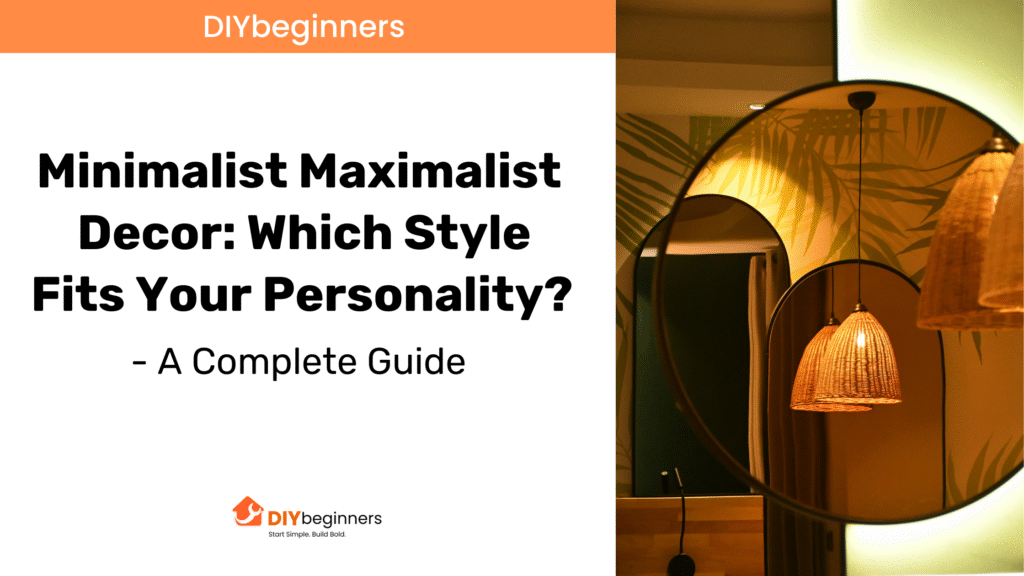
The interior design world offers a plethora of choices; however, few can be as distinct as minimalism and maximalism. The choice of minimalist vs maximalist styles of decor is mostly based on your personality and lifestyle choices. Where one is taking pride in emptiness and will, another is taking pride in plenty and individuality.
In this guide, we shall take a look at both these philosophies of design and how they tend to deal with the essential attributes of a philosophical design, advantages and disadvantages of the same, and how they may relate to various personality types. At the end, you will have a better idea of what direction you will find appealing to your aesthetic sensitivities and practical requirements.
Understanding Minimalist Maximalist Decor: Core Philosophies
The two styles are in their ultimate for,m, totally divergent approaches to the filling of our living environment. The potential implications of the opposition between minimalist and maximalist interior design techniques present some possibilities to give personal expression in your dwelling.
1. Minimalist Decor: The Art of Simplicity and Function
Minimalist decor is very calm and organized, the clean, sharp lines and purposeful spacing. The mantra that less is more, minimalism was born in the mid-twentieth century and centers around:
- Clean, clutter-free environments that feature negative space
- Grey color schemes that were mainly white, beige, and grey colored
- Practical, useful objects mostly without decoration
- A lot of quality, not quantity ty, in everything
- Storing solutions that are not revealed to the eye
A minimalist room appears spacious and free- breathe. Each article has been justified by its utilization and design. Nothing is just there to be pretty- beauty lies in the simplicity and curation. The old architect Ludwig Mies van der Rohe once stated: God is in the details. The details are not overlooked in minimalism, and each part has a purpose other than adding decor to the piece.
2. Maximalist Decor: Embracing Abundance and Expression
At the other extreme, maximalist decor hails in the glory of excess, color, a nd personal objects that have a story to tell about yourself. This style proclaims that more is more, and it has the following features:
- Vibrant colors and patterns will be mixed with bold color schemes
- Assemblies are multi-textured and eclectic
- Honest and well-crafted exhibits
- Pieces of statement furniture that are demanding
- Rich textiles and a different combination of materials in the entire space
A maximalist room is vibrant and alive, and has stories and visual appeal. It is an open area showcasing personality through all the chosen apparatus and generating an atmospheric re-evoking the sense and encouraging exploration..
Early proponent of maximalist ideals designer shouted that in her life that the unexpected thing makes people stand up and take notice, the designer Dorothy Draper. Maximalism follows such philosophy to the fullest extent.
The Psychology Behind Your Style Preference
Your attraction to either minimalist or maximalist design often reflects deeper aspects of your personality and how you process the world around you.
1. Minimalist Personalities Often:
- Value order and predictability
- Find peace in simplicity
- Feel overwhelmed by visual clutter
- Prefer quality over quantity
- Make decisions efficiently
- Appreciate subtle details
- Seek calm environments for thinking
2. Maximalist Personalities Often:
- Embrace variety and stimulation
- Express themselves boldly
- Collect meaningful objects
- Value stories and memories
- Enjoy creative combinations
- Seek energizing environments
- Find comfort in abundance
Transforming Spaces with Maximalist Home Decor
With the maximalist home style, remember to curate items and not necessarily collect them. The correct reply to maximalism is not avoiding clutter but doing it deliberately. The following are some of the best ways of going honestly with this style:
1. Start with a Color Story
Start with a unified choice of colors that give some diversity, but which retain certain order. That can include:
- About 3-4 complementary colours on a base
- Pop tags that contrast what you wear
- Styles that use your selected palette
2. Layer Textures and Materials
Create depth with varying textures.. Edit some images. Create depth by juxtaposing different textures.s Edit some pictures:
- Combine even surfaces with rough surfaces
- Combine the manufactured materials with natural ones
- Different layers of textiles of different weights and finishes
3. Create Vignettes
Rather than stuffing commercials on the floor or table, curate some collections by thinking about it:
- Group by theme, col, or size
- Varthe y the heights to form interest in the visuals
- Each grouping must have a story or give a focal point
4. Balance Through Repetition
Repeat to establish cohesion:
- Mirrors the space in color
- Replicate similar patterns, or patterns of different dimensions
- Apply the same sort of framing to art or photographs
The Minimalist Approach: Finding Freedom in Less
Minimalist decor offers a different kind of freedom—one found in simplicity and intentionality. Here’s how to embrace this approach:
1. Start with Purpose
The question to be asked before you put anything in your space would be:
- Is this functional?
- Does it cause real delight?
- Does the space have to work?
2. Embrace Negative Space
Do not feel the Necessity to cram all Surfaces:
- Permit walls to breathe with little paintings
- Store surfaces without anything but the necessities
- Insert visual separations between furnishings and ornamentation
3. Focus on Quality
The less you have in your space, the more significant each item is:
- Buy quality items
- Select classical designs and not trends
- Choose the materials that age gracefully
4. Maintain Mindfully
You need to set up mechanisms to facilitate your health-centered living:
- Enact a new purchase one-in-one policy
- Restock less of an item that is no longer serving you
- Design secret compartments to store important items that are often distracting to the eye
Which Style Truly Fits You? A Self-Assessment
1. How do you feel in cluttered environments?
- Stressed and overburdened → Tendencies towards
- Minimalism Easy and inspired → Maximalism inclinations
2. What’s your approach to shopping?
- Intelligent, studied buying habits –> Minimalist habits
- Unplanned, emotional purchases, a feature of becoming a maximalist
3. How do you display meaningful items?
- Exclusively display some choice of work -> Minimalism
- Establish museums and exhibits of numerous objects and artefacts → Maximalism
4. What colors make you feel at home?
- Neutrals and soft tones → Minimalism is big
- Rich, saturated colors → The Maximalist look
5. How often do you redecorate or rearrange?
- Unoften, more consistent with tendency, rather than variety, preferring clearness and economy -> Minimalist dispositions.
- Commons: Often enjoying change (tendencies) Maximalist
Current Trends in Minimalist and Maximalist Design (2025)
1. 2025 Minimalist Trends:
- Warm minimalism with the tone of soil-neutral over stark white
- Frill Organic materials to bring natural texture
- Rounded lines comply with the rigidity of the geometric
- Burdenless technology integration that goes away when not needed
- Sustainably thought to mumulti-functionallieces with a clean silhouette
2. 2025 Maximalist Trends:
- Nature-inspired maximalism, floral prints, bio-inspired detail
- Vintage revival, using heirloom and second-hand items
- Pattern drenching, in which a single pattern can be spread across more than one surface
- Universal trends that produce cultural talking points
- Statement ceilings that attract the eye upwards
Conclusion: Finding Your Authentic Style
The grace of interior design is that it communicates what we want to communicate. Your style should be authentic, be inspired by the calm aesthetic of minimalism or the expressive exuberance of maximalism, or anything in between.
Your dwelling should be a reflection of you- assisting in your way of life, revealing your character, and building the emotional feel to your home you seek. The only incorrect responses to personal style are either responses that resonate or do not.
It is fine to remember that styles may change along with you. It happens that the preferences of many individuals change according to the phases of their lives, the conditions in which they live, or even with the seasons. It is no sin to experiment, adjust, and create a place that you feel like home, whatever that means to you.
The most successful spaces are not those that are designed by the book but are the ones that truly portray their occupants. Therefore, whether you are a minimalist, a maximalist, or both, do what you feel makes sense to you and be able to create a place where you feel like it is your own.
